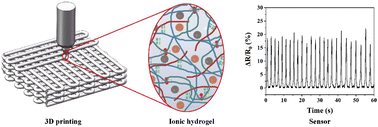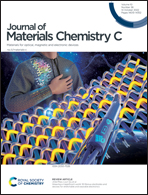3D printable conductive ionic hydrogels with self-adhesion performance for strain sensing†
Abstract
Nowadays, developing skin-type strain sensors based on multi-functional and conductive hydrogels with superior toughness and self-adhesion properties to withstand cyclic loading situations as well as fast electrical signal transmission is of great significance. Herein, a kind of novel 3D printable hydrogel with good conductivity, excellent self-adhesion properties, and robust interface combination with an elastomers substrate was prepared successfully. Specifically, such printable hydrogels are prepared by combining a physical network of polyvinyl alcohol (PVA) with chitosan (CS) and a chemical network of polyacrylamide (PAM), followed by subsequent immersion into sodium tetraborate pentahydrate solution to achieve ionic conductive features. Moreover, the dynamic hydrogen bonding interactions between the tetrafunctional borate ions and −OH groups in the PVA chains, endow the hydrogels with remarkable self-adhesion behavior independent of any external stimuli. The as-prepared ionic conductive hydrogels exhibit great application potential as intelligent strain sensors in the field of wearable devices for monitoring various motions and behavior of limbs or organs.



 Please wait while we load your content...
Please wait while we load your content...